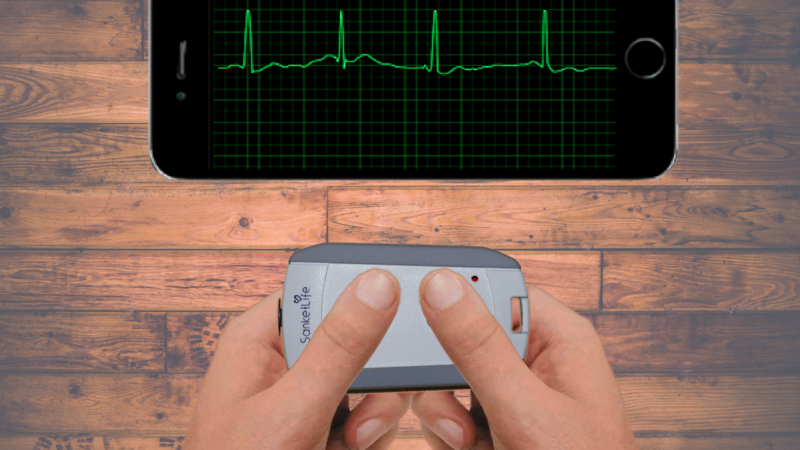
In the age of smartphones, personal Cardiac monitoring is becoming more and more needed and useful practice. This enables the patient to keep a check on his health data as well as share it with his medical provider in case of an emergency. Cardiac monitoring is one such monitoring which is much needed in today’s time, as cardiac diseases are on a rise globally.
ECG is the electrical activity of the heart. Which shows the result in form of the trace with the strange shape of a healthy heart. Whenever there is a problem like abnormal heart rhythm, damage in heart muscles, the ECG graph shows a change. Usually to take an EKG electrode with long leads are attached to the chest, arms, and legs with suction cups and sticky gel.
A cardiac monitor is a portable, battery operated device which is used for cardiac monitoring and event recording whenever there is an episode of cardiac symptoms like faster or slower heartbeats, chest pain etc. Cardiac monitors are also used to see the effect of medicines when some person is on medication.
Most cardiac monitors measure ECG by wearing the device 24 hrs. With the advent of smartphones, such monitors have now become sensor based which means no electrodes need to be attached to the body and they are connected with smartphones via Bluetooth to provide more portability, real-time data transmission, and flexibility to the user. This makes heart patients monitor their heart themselves and report any problem to the doctor whenever needed.
How Advances in Sensor Enable Portable Cardiac Monitors Improve the Heart Patient and Clinician Experience?
Use of traditional Event Monitor or recorder leads Could have been a problem for cardiac patient’s compliance and comfort. The newer generation cardiac monitors do not even use a little patch, leads, and gels. Nowadays cardiac monitors allow us to capture ECG anytime anywhere.
Whereas, traditional Event Monitor had to be worn 24X7 by Cardiac patients. Advances in the technology of Sensor enable ECG Monitors concerted with the smartphone are not only improving the cardiac patient experience but also improving the effectiveness of clinicians to collect the instant ECG report and analyses ECG-based heart activity.
Traditional event monitor resulted in low cardiac patient compliance and delayed access to patient ECG data. While ECG monitoring technology is easy for patients and provides clinicians. It provides instant access to an analysis of patient ECG data via smartphones.
What were the Challenges of Previous Technology?
“Patients did not feel comfortable to walking around with a box on their hip,” Hauser said. “They could not have a take bath and also could not do all of the things they needed to do to get a regular 2 -3 days period.”
This practice was problematic in getting right and beneficial advice. Conventional ECG monitors were the sole solution for heart monitoring.
Now One question comes into my mind, was traditional cardiac monitor safe? Yes, Of course, The wearable Cardiac monitors were safe. However, for those who didn’t have any kind of skin allergy. In case of Skin problem then had to be Certain to ask their cardiologist. Because it was necessary to attach electrodes to the skin using gel.
The majority of the people weren’t comfy to use the traditional cardiac monitor. You needed to write down the specific time that you had been experiencing symptoms. And many times patients didn’t use the journal so they had no idea when they were symptomatic.
Moving beyond the traditional cardiac monitoring
Sometimes there wouldn’t be any report. And you’d need to get on your telephone and speak with the service provider. “It had been very ineffective and usually not comparable with almost any amount of satisfaction”. The second generation of monitors can be worn for seven days to fourteen days.
After the monitoring period. The clinicians sent the device into the producer or perhaps even a service provider to test. And make a report on this individual’s ECG rhythm actions. This procedure prevents clinicians from obtaining and analyzing information promptly and supposed that the service provider recorded the vast majority of their numerical price.
Improving the Patient and Clinician Experience with modern Cardiac monitor
ECG interpretation could be your ideal approach to quantify and diagnose arrhythmia conditions. So, it was much needed to upgrade the patient and clinician experience of taking an ECG. After continuous study and research now the innovative Leadless 12 Lead ECG Monitor has been invented today. It provides the complete cardiac diagnosis just by the touch of sensors.
The newest 12 Lead Cardiac Monitor is small, lightweight, keychain size, pocket-friendly. It is easy to carry and very handy. Also, It’s connected to the smartphone and cloud so that the report can be printed and shared instantly for review. Also, previous reports can be fetched from the cloud to analysis the changes in ECG data immediately instead of going through a third party.
“That’s a very refreshing thing”
It is patient-friendly, comprehensive and complete Heart check system for everyone. Next generation leadless monitors that offer the ECG report in a matter of minutes can be easily used to detect and monitor Arrhythmias and Heart Rhythm problems. Even at the time of Heart Attack, such a device is very useful to differentiate between normal chest pain and a heart attack and save valuable time.
So nowadays the penetration of this system in hospitals and clinics is very high. For those clinicians, who are very busy, it’s a complete level of improvement, from a 3-star to a 5-star.” Moreover, because this portable leadless technology eliminates the need for multiple clinical hand-offs, it offers greater operational efficiency and amazing savings for patients and doctors. Also allows us to retrieve data on a patient’s cardiac activity quickly is critical for managing heart rhythm disorders.
